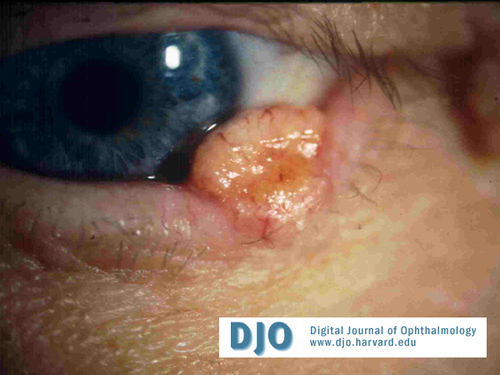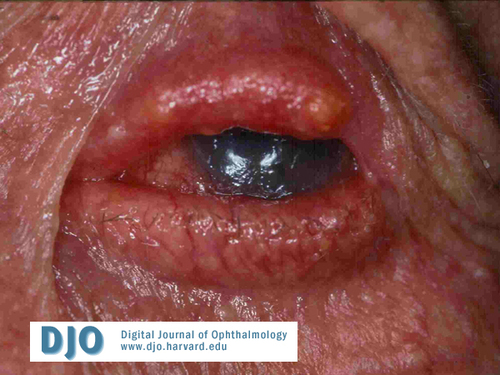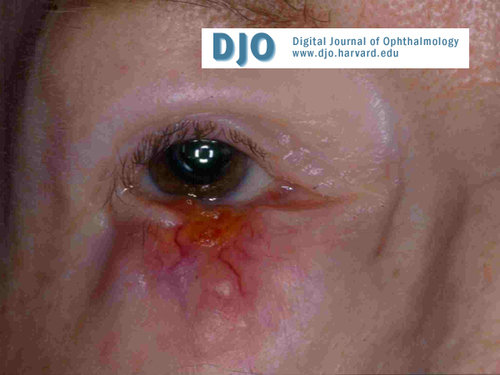Orbit/Oculoplastics Quiz 15

Figure 1
Clinical appearance at presentation
Clinical appearance at presentation

Figure 2
Sebaceous carcinoma masquerading as blepharoconjunctivitis
Sebaceous carcinoma masquerading as blepharoconjunctivitis

Figure 3
Sebaceous carcinoma presenting as an eyelid lesion involving all layers of the eyelid
Sebaceous carcinoma presenting as an eyelid lesion involving all layers of the eyelid
Answer: Sebaceous carcinoma
2. What is the etiology of this lesion?
Answer: Sebaceous carcinoma is a rare but potentially lethal tumor that arises from sebaceous glands in the periocular region. Most frequently, it originates in the meibomian glands of the tarsal plate, but it can also arise from the glands of Zeis at the eyelid margin, or the sebaceous glands of the caruncle and eyebrow.
3. What are the characteristic clinical and histological features of this condition?
Answer: Sebaceous carcinoma is more common in women (73%), and in patients greater than 60 years old. It may also be seen in younger patients who have a history of radiation exposure to the face. Sebaceous carcinoma preferentially affects the upper eyelid (75%), with fewer cases involving the lower eyelid (22%), conjunctiva (2%), and caruncle (2%). Classically, sebaceous carcinoma presents with a painless, firm nodule that may have a yellow hue, due to the lipid material in the malignant cells. It often simulates a chronic chalazion. Adjacent cilia at the eyelid margin are destroyed, causing madarosis. Sebaceous carcinoma can also present with diffuse thickening of the eyelids, simulating inflammatory blepharoconjunctivitis (Figure 2), or it can involve all layers of the eyelid (Figure 3). It may also masquerade as a superior limbic keratitis, an anterior orbital mass, or a lacrimal gland mass.
Histologically, sebaceous carcinoma is characterized by replacement of the normal lobules of the sebaceous glands by large anaplastic cells with foamy cytoplasm. Pagetoid spread describes one growth pattern of sebaceous carcinoma, in which single neoplastic cells or small clumps of cells migrate into the epithelium of the conjunctiva, cornea, and eyelid skin, causing multifocal involvement. Sebaceous carcinoma can also invade into the epithelium and replace the full thickness surface epithelium with malignant cells, resembling squamous cell carcinoma in situ. Oil red-O staining is used to confirm the presence of lipid material in frozen sections of lesions suspicious for sebaceous carcinoma.
4. What is the clinical course of this condition?
Answer: Sebaceous carcinoma can spread by direct extension into the orbit, paranasal sinuses, and the brain. Metastasis via lymphatic channels occurs most commonly in the preauricular, parotid, and cervical lymph nodes. Distant spread of disease can be fatal.
5. What are the treatment options?
Answer: Excision of tumor with frozen section or Mohs’ micrographic surgery is performed. Additionally, multiple conjunctival map biopsies taken from all areas of the conjunctiva are used to survey for areas of pagetoid spread. Small areas of conjunctival involvement are surgically excised and cryotherapy is applied to the borders of these lesions. In cases with more extensive conjunctival intraepithelial disease, topical chemotherapy has been shown to be effective in causing tumor regression in small prospective uncontrolled trials. Periocular radiotherapy has a palliative effect on sebaceous carcinoma, but is not curative. When orbital involvement is present, exenteration is performed to decrease the chance of metastasis and improve survival.
References
1. Shields JA, et al. Sebaceous Carcinoma of the Eyelids: Personal Experience with 60 Cases. Ophthalmology 2004;111:2151-2157.
2. Cook BE, Bartley GB. Treatment Options and Future Prospects for the Management of Eyelid Malignancies: An Evidence-based Update. Ophthalmology 2001;108:2088-2100.
3. Shields CL, et al. Topical Mitomycin-C for Pagetoid Invasion of the Conjunctiva by Eyelid Sebaceous Gland Carcinoma. Ophthalmology 2002;109:2129-2133.